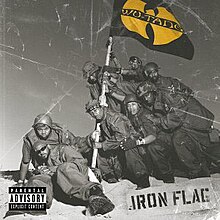Iron Flag
| Iron Flag | ||||
|---|---|---|---|---|
 |
||||
| Studio album by Wu-Tang Clan | ||||
| Released | December 18, 2001 | |||
| Recorded | 2001 | |||
| Genre | Hip hop | |||
| Label |
Loud/Columbia/Relativity CK 86236 |
|||
| Producer | RZA, True Master, Mathematics, Nick Fury, Trackmasters | |||
| Wu-Tang Clan chronology | ||||
|
||||
| Professional ratings | |
|---|---|
| Aggregate scores | |
| Source | Rating |
| Metacritic | (69/100) link |
| Review scores | |
| Source | Rating |
| Allmusic |
|
| The A.V. Club | (favorable) link |
| Blender |
|
| Entertainment Weekly | (B+) link |
| The New York Times | (favorable) link |
| LA Weekly | (favorable) link at the Wayback Machine (archived August 23, 2002) |
| Pitchfork Media | (7.5/10) link |
| Robert Christgau | |
| Rolling Stone |
|
| Rolling Stone |
|
| Stylus | (A-) link |
Iron Flag is the fourth studio album by American East Coast hip hop collective Wu-Tang Clan, released on December 18, 2001 on Loud Records. It was certified gold in sales by the RIAA. Iron Flag served as the group's second lowest-selling album (687,000 copies), as their record label, Loud, was on the verge of shutting down at the time. The album debuted at No. 32 on the Billboard 200 with 153,000 copies sold in its first week of release. It has sold 500,000 copies in the United States, & certified Gold by the RIAA on January 29, 2002.
A gap of four years separated both the first and second albums; and three years between the second and third albums; with those gaps being filled by a myriad of solo projects. It was consequently surprising to many when the Clan reformed for a new LP only a year after their well-received 2000 album The W, with only RZA's Digital Bullet and Ghostface Killah's Bulletproof Wallets released in between. The album's promotion was also quite low-key, particularly in comparison to the fanfare, hype and expensive videos that had preceded the release of the group's two previous albums. Unusual for hip hop albums of the time, Iron Flag only consists of twelve tracks (which contain thirteen songs plus a short introduction) with no interludes or skits between songs. This is similar to The W, which only consisted of thirteen tracks (though unlike Iron Flag it did feature interludes and skits).
The album cover is inspired by the Iwo Jima flag-raising photo from 1945, one of the most famous photos of all time.
Ol' Dirty Bastard's contributions to the Wu-Tang's group albums continued to decrease with each successive album: after being one of the main stars of Enter the Wu-Tang: 36 Chambers, he was by far the least prolific Clan member on the group's follow-up album Wu-Tang Forever. He then made only one appearance on The W (on the song "Conditioner") due to being engulfed in legal troubles; legal troubles which in the year separating The W and Iron Flag had only gotten worse. Consequently, ODB does not appear on Iron Flag at all, making The W the final Wu-Tang album to feature him. He does, however, appear on 8 Diagrams posthumously.
...
Wikipedia
